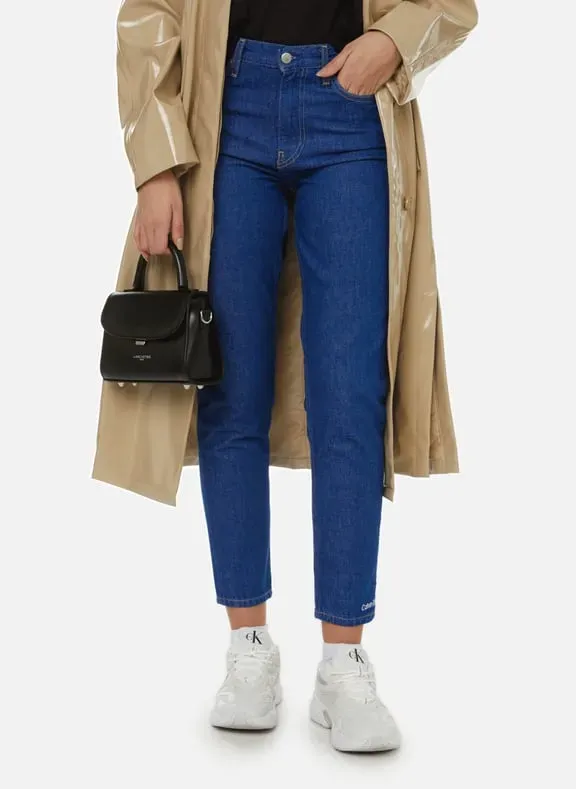Calvin Klein jeans recycling is at the forefront of a revolutionary movement against the waste generated by the fast fashion industry. With the staggering amount of textile waste piling up in places like the Atacama Desert, brands like Calvin Klein are being called to action to adopt sustainable practices. This initiative not only emphasizes the importance of reusing and recycling but also challenges consumers to rethink their purchasing behaviors in the context of a fast-paced fashion landscape. By promoting clothing re-commerce, the project aims to give discarded yet high-quality items a second life, while simultaneously reducing the environmental impact caused by textile waste. In doing so, Calvin Klein and similar brands can take significant strides towards a more sustainable fashion future, reducing their carbon footprint and promoting awareness about the urgent need for change.
The recycling of Calvin Klein jeans represents a crucial step in the fight against rampant textile waste and a shift towards responsible fashion practices. Brands are increasingly being pressured to adopt sustainable approaches amidst growing concerns over fast fashion’s impact on the environment. This movement not only highlights the potential of repurposing perfectly usable garments but also encourages consumers to engage in circular fashion initiatives. In light of this, the concept of clothing re-commerce is gaining traction, providing an eco-friendly alternative to the traditional retail model. With thousands of discarded garments littering areas like the Atacama Desert, it is more important than ever that the fashion industry reevaluates its practices and embraces a sustainable future.
The Impact of Fast Fashion on Textile Waste
Fast fashion has revolutionized the clothing industry, offering consumers low-priced garments that are frequently updated to align with the latest trends. However, this rapid production cycle is a contributing factor to an alarming 92 million tons of textile waste produced annually. Unsold clothing often ends up in landfills, contributing to environmental pollution. Brands churn out multiple collections per year, leading to a throwaway culture where garments are often deemed disposable. As a result, perfectly wearable clothing is discarded, which adversely affects the environment and showcases a growing textile waste crisis.
In regions like the Atacama Desert, the consequences of this model are starkly visible. The desert acts as a dumping ground for unworn garments that were primarily crafted in countries like China and Bangladesh. This not only harms local ecosystems but also exemplifies the dark side of the fashion industry. Fast fashion’s insatiable appetite perpetuates a cycle of overconsumption and wastefulness, fundamentally questioning the sustainability of such practices in a world that desperately needs to pivot towards more responsible consumption.
Calvin Klein Jeans Recycling Initiative
The Calvin Klein jeans recycling initiative exemplifies an innovative approach to combatting the ongoing crisis of textile waste. By repurposing and redistributing discarded Calvin Klein jeans found in areas like the Atacama Desert, this program not only highlights the plight of affected regions but also promotes sustainability through the concept of clothing re-commerce. Consumers are offered the chance to acquire these high-quality garments for free, paying only for shipping, effectively breaking the cycle of waste and encouraging recycling instead. Such initiatives challenge the traditional fashion model, urging brands to take accountability for their environmental impact.
Moreover, partnerships with organizations like Desierto Vestido emphasize community engagement and activism beyond mere charity. By highlighting the narrative of discarded jeans and their journey from waste to wear, the initiative fosters awareness about the amount of textile waste generated by the fashion industry. As influencers promote the campaign on social media, it reinforces the idea that consumers can play a pivotal role in changing societal norms about garment ownership and disposal. The remarkable response to the initial release of Calvin Klein jeans signifies a shift toward sustainable fashion practices that could potentially redefine consumer behavior.
Sustainable Fashion and Circular Economy
Sustainable fashion embodies a paradigmatic shift from a throwaway culture to the principles of circularity. It reflects a growing awareness of the environmental costs associated with producing clothing. Initiatives like the Re-commerce Atacama campaign exemplify how organizations aim to not only reduce waste but also create value from discarded textiles. By transforming what was once seen as waste into desirable items, they promote a circular economy where garments are reused rather than discarded. This approach resonates with consumers, creating a demand for more sustainable practices in the fashion industry.
In redefining the relationship between people and their clothing, sustainable fashion encourages a deeper connection and commitment. This may involve purchasing higher-quality items less frequently, opting for secondhand clothing, or participating in recycling programs. By adopting these practices, consumers can mitigate their footprint on the planet, especially in regions plagued by textile waste. Ultimately, the transition towards sustainable fashion is not merely a trend; it represents a critical movement towards environmental stewardship and responsible consumer behavior.
The Story of Textile Waste in the Atacama Desert
The Atacama Desert is notorious for its desolate beauty, but it has become a troubling symbol of textile waste resulting from the fast fashion industry. Each week, Bastián Barria and his team search the sands for discarded clothing, often recovering garments that are still wearable. This reality underscores the alarming trend of textile waste, where millions of tons of clothing end up in remote locations rather than being recycled or reused. The fact that garments are simply dumped, despite being in good condition, raises questions about consumerism and the ethical responsibilities of clothing brands.
This issue resonates globally, as it speaks to a pattern seen in many developing nations which become dumping grounds for the world’s textile waste. Sustainable solutions are urgently needed to combat this crisis, which is exacerbated by the conventional approach of disposing of unsold or unwanted clothing. By shedding light on this grim reality, campaigns like Re-commerce Atacama aim to mobilize public consciousness and inspire grassroots movements that address both waste and fashion justice.
The Urgency for Change in Fashion Production
With fast fashion producing ever-increasing volumes of clothing, it is crucial to recognize the urgent need for change within the industry. This demand for more rapid production cycles has led to an overwhelming amount of waste, where every second a truckload of textiles is discarded. As noted by industry experts, this model is not only environmentally unsustainable but also raises ethical concerns about labor practices and the exploitation of resources in countries producing raw materials. To mitigate these issues, the focus must shift toward transparency and ethical production methods that prioritize sustainability over profit.
Fashion stakeholders must come together to innovate and seek solutions that reduce waste and promote the re-use and recycling of materials. This involves reevaluating supply chains, engaging in environmentally friendly practices, and recognizing the long-term value of clothing and materials. Emphasizing a model of responsible consumption is essential to advancing towards a fashion industry where sustainability and ethical standards take precedence, ultimately transforming the way we perceive clothing production and its impact on our planet.
Rethinking Consumerism in the Fashion Industry
As awareness of textile waste grows, so too does the conversation surrounding consumer habits and the role they play in the fashion ecosystem. The relentless cycle of purchasing new clothes has created a society that views garments as disposable, leading to mountains of waste in places like the Atacama Desert. By consciously choosing to prioritize quality over quantity, consumers can challenge the fast fashion model and influence brands to adopt more sustainable practices. By participating in clothing re-commerce initiatives, individuals can embrace a smaller environmental footprint through thoughtful choices.
Encouraging consumers to make informed decisions about their purchases is critical in shifting the narrative around fast fashion. By changing their relationship with clothing, individuals can go beyond the allure of trends, opting instead for sustainable alternatives that respect human rights and the environment. As more people engage in conscious consumerism, the push for a more ethical and sustainable fashion industry becomes increasingly powerful, allowing for a collective effort to reduce textile waste.
Fashion Activism and Catalyzing Change
Fashion activism takes on a vital role in challenging the prevailing notions of fast fashion and textile waste. Initiatives like the Re-commerce Atacama campaign shine a spotlight on the issues surrounding wasteful consumer practices and invite people to engage actively in solutions. Fashion activists advocate for accountability from brands and encourage consumers to think critically about their purchasing behaviors. By utilizing social media platforms, ordinary individuals can amplify their messages, raising awareness about the environmental and social ramifications of fast fashion.
The collective efforts of activists, including organizations like Fashion Revolution Brazil, create meaningful dialogues that push for systemic change. By encouraging people to see fashion as a vehicle for activism, they inspire a movement that seeks to redefine the fashion landscape. This transformation doesn’t just benefit consumers but also promotes ethical production practices, ensuring that future generations inherit not only styles but also a sustainable approach to fashion.
Collaborative Efforts for Sustainable Solutions
The complex issues associated with textile waste can often feel overwhelming, but collaborative efforts demonstrate the potential for real change. Organizations, fashion brands, and activists have united to create initiatives that highlight the need for sustainable solutions in the fashion industry. Through partnerships, such as those seen with Calvin Klein jeans recycling, efforts are being made to repurpose discarded garments and raise awareness regarding the environmental impact of textile waste. These collaborations not only extend the life of clothing but also foster community involvement in the pursuit of a healthier planet.
Moreover, educational campaigns play a pivotal role in informing consumers of the realities behind fast fashion and enticing them to participate in sustainable practices. By engaging the public through workshops, distribution of information, and online platforms, these collective efforts have the potential to cultivate a movement where sustainability is celebrated and prioritized. Community-centric initiatives have proven to be effective in not only mitigating textile waste but also in reshaping perceptions regarding the value of clothing, paving the way for a brighter ecological future.
The Global Nature of Textile Waste and Responsibility
Textile waste is a global issue that extends beyond the borders of any single nation. The discarded clothing we see in the Atacama Desert reflects a broader systemic problem where wealthier countries export their waste to nations in the global south. This practice, labeled both colonialist and exploitative, reveals the urgent need for a shift in how we view and engage with production and consumption worldwide. Awareness of these dynamics is crucial to fostering a sense of responsibility among consumers and brands alike.
By recognizing the interconnectedness of global fashion markets, individuals can advocate for integrity within the industry. Addressing fast fashion’s wasteful practices signifies holding brands accountable while promoting sustainable solutions. It’s vital to support legislation that enforces environmentally friendly practices, encouraging companies to adopt a more responsible approach to production and distribution. Ultimately, fostering a culture of responsibility within the fashion industry is key in tackling the phenomenon of textile waste effectively.
Frequently Asked Questions
What initiatives are being taken for Calvin Klein jeans recycling in the Atacama Desert?
The Re-commerce Atacama initiative focuses on recycling Calvin Klein jeans and other discarded clothing found in the Atacama Desert. The program collects garments, restores them, and offers them for free, except for shipping costs, to raise awareness about textile waste and promote sustainable fashion.
How does Calvin Klein jeans recycling address fast fashion issues?
Calvin Klein jeans recycling plays a significant role in combating fast fashion by repurposing perfectly usable garments that have been discarded. This initiative highlights the environmental impact of textile waste from fast fashion, particularly in regions like the Atacama Desert.
What is the impact of textile waste on sustainable fashion as seen in Calvin Klein jeans recycling?
Textile waste, including that from Calvin Klein jeans, poses a major challenge to sustainable fashion. The recycling initiatives in the Atacama Desert aim to mitigate this issue by promoting circularity in fashion, where garments are reused rather than ending up in landfills.
How does clothing re-commerce relate to the recycling of Calvin Klein jeans?
Clothing re-commerce involves the resale or redistribution of secondhand garments, including Calvin Klein jeans, which have been collected from waste sites. This process encourages a shift towards more sustainable fashion practices and reduces the volume of textile waste generated.
Why is the Atacama Desert a significant site for Calvin Klein jeans recycling efforts?
The Atacama Desert is a significant site for Calvin Klein jeans recycling due to the alarming amounts of textile waste found there. The desert has become a dumping ground for discarded clothing, making it crucial for initiatives like Re-commerce Atacama to address and raise awareness about this environmental issue.
What can consumers do to support Calvin Klein jeans recycling and sustainable fashion?
Consumers can support Calvin Klein jeans recycling by participating in initiatives like Re-commerce Atacama, advocating for sustainable fashion, purchasing secondhand clothing, and being mindful of their own consumption patterns in the fast fashion industry.
| Key Points |
|---|
| Bastián Barria collects discarded clothing in the Atacama Desert, highlighting the issue of textile waste. |
| Over 131,000 tons of clothing arrived in Chile in 2022, with 70% ending up discarded in the desert. |
| Re-commerce Atacama campaign aims to raise awareness about textile waste and promote recycling of branded clothes. |
| Calvin Klein jeans and other branded items are given away for free, only requiring customers to pay for shipping. |
| Project involves collaboration with organizations and influencers to promote sustainable fashion practices. |
| Fashion Revolution Brazil emphasizes the need for transparency and a rethink of the fast fashion model. |
| The alarming rate of clothing waste is a global crisis, impacting communities in countries like Chile and Ghana. |
Summary
Calvin Klein jeans recycling is part of a broader initiative to combat the growing problem of textile waste, particularly visible in places like the Atacama Desert in Chile. With campaigns like Re-commerce Atacama, the aim is to not only repurpose high-quality garments but also raise awareness of the environmental impact of fast fashion. As awareness of these issues grows, it’s clear that a shift toward sustainability in fashion is paramount. This initiative highlights a significant step in promoting recycling and responsible consumption, showing that change is possible in how we view and treat discarded clothing.




